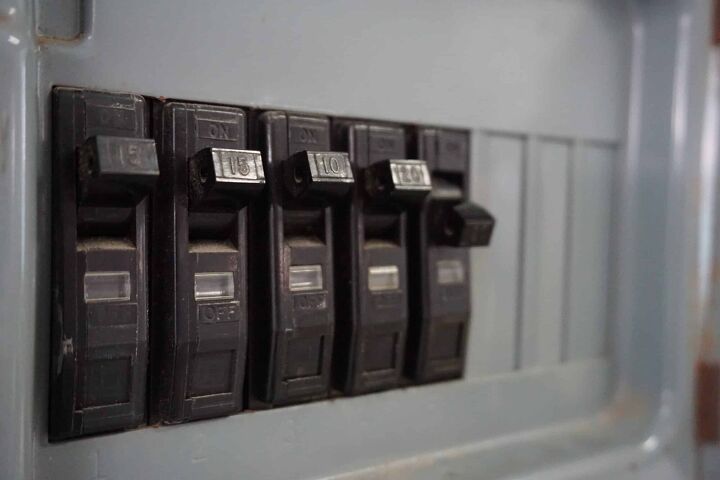How To Change A Circuit Breaker From 15 To 20 Amp

Picture this: you walk into your living room and turn on the lights. You’re about to vacuum your rug, but after plugging the vacuum in, the lights go out. The cause is likely your circuit breaker.
If you’re wondering how to change a circuit breaker from one amp size to another, you’re in the right place. The easiest way to put it is it can’t be done safely. Trying to do so can cause long-term damage to your home.
But don’t let that make you feel defeated. There are things you can do to determine why you’re experiencing circuit breaker issues.
Let’s take a look at what some of the issues could be and the solutions.
Do You Need to Hire an Electrician?
Get free, zero-commitment quotes from pro contractors near you.

Safety First
There are a myriad of safety precautions to take before you start working with a circuit breaker. Whether you’re replacing one or just doing an inspection, you’ll want to keep these in mind.
To keep yourself, your home, and your family safe, here are the top seven tips.
1. Turn Off All Power
The first thing you want to do is turn off the main breaker. Ensure that it’s wholly isolated before you begin working. Even if you’re doing an inspection, this step should be followed.
2. Wear Protective Gear
Sometimes there’s a possibility of an arc flash hazard. If this is possible for your electric situation, consider wearing personal protective equipment.
How do you know if this can happen for you? Check to see if there are exposed circuit parts. Also, if the circuit breaker wasn’t correctly installed, PPE is a must.
3. Choose The Proper Circuit Breaker
The third safety tip is to make sure the breaker you have is compatible with the existing panel. It’s relatively easy to do this if you haven’t already.
Take a look at the amperage rating and wiring numbers. In the troubleshooting section of this post, we’ll dive deeper into how to do that.
4. Inspect Tools And New Parts
Before you start working on a circuit breaker, take a look at the tools you have. If there is any damage, replace them with new ones.
You’ll also want to do this with any wiring and parts you’re using. This ensures that the connections will work and last a long time.
5. Be Aware Of What Is Still Hot
You’ve already turned the main breaker off, and you’re ready to work. Something to keep in mind is that the main bus bar can still be hot.
This can be said for the conductors leading into the panels as well. Depending on your circumstances, you can wait until it cools off or take precautionary measures.
6. Inspect before Turning On
The penultimate safety tip is to have a licensed technician take a look at all the parts and connections. This inspection is done to make sure long-term damage isn’t done to the entire panel.
You should NEVER flip the breaker to see whether or not it’s working. It could lead to severe damage and even cause an electrical fire.
7. Perform Regular Maintenance
Last but certainly not least is to perform regular maintenance on the circuit breaker panel. There’s no denying that over time, breakers get worn out and old.
Inspecting them regularly ensures that everything is working accordingly. You’ll also be able to spot issues before significant problems cause irreversible damage.
Trial and Error
To fix any issue in your home, trial and error is the go-to method. This can help you easily figure out where to start when it comes to getting things resolved.
Here are a few of the top reasons you may be considering an amp upgrade:
There’s a Short Circuit
One of the most apparent issues you may be facing is a short circuit. If this is fixed, you may not need to upgrade your breaker amps. Whether or not it’s tripping because of an increased load or a short circuit makes a big difference. If it’s tripping while you’re using the vacuum cleaner, it’s likely NOT shorting out.
What you want to do is locate the panel, which is usually found in the basement or an upstairs closet. The tripped breaker will be in the middle position, instead of to one side or another. Try turning the switch off and on again. If you attempt vacuuming, or any other electric test, see if it trips out again. It should remain on at this point.
If it doesn’t, that’s a sign of a short circuit. Time to look up local electricians and get to the root of the issue.
Checking the Wire Gauge
If it’s not a short circuit, the next thing you can do is check the wire gauge. Making sure you are using the correct wire size is crucial. It’s actually one of the reasons you can’t safely change from a 15 to 20 amp breaker.
There are a couple of different ways you can get this done. The first way is just by removing the front of the panel and checking the wire coming into the breaker.
Your other option is removing the cover from one of the outlets in the circuit completely and examining what fire is feeding into it. Whichever option you go with, note that you may have to loosen some screws to get to the wiring. Be aware of where your screwdriver is when you’re doing this. You may get shocked if the metal of the tool is touching the screws on the outlet.
Wiring Sizing
Something to keep in mind is that there are codes to follow. The National Electrical Code requires that 20 amp circuits be wired with 12 gauge wire.
If you’re unsure of what size that looks like, you can ask your local hardware store for a sample. Bring the sample home and compare it to what you’re already using. If the strands are smaller, you won’t be able to upgrade. Some homes have multiple outlet boxes. It’s a good idea to check the wire gauge in both boxes for safety purposes.
This chart can make everything easy to follow if you need extra aid.
| KW | Volts | Breaker Size | Power (Amps) | Avg. Wire Size |
| 3 | 120 | 30 | 29 | 10 |
| 7 | 240 | 30 | 29 | 10 |
| 9 | 240 | 40 | 38 | 8 |
| 3 | 240 | 60 | 54 | 6 |
| 8 | 240 | (2) 40 | 75 | (2) 8 |
| 27 | 240 | (2) 60 | 112 | (2) 6 |
In addition, 15 amp averages a size 14-gauge wire. Twenty amps average a 12-gauge wire.
Related Questions
Can I put a 20 amp breaker in place of a 15 amp breaker?
The short is that it’s possible. If you do decide to do this, you’ll want an electrician evaluating the situation. However, you should never go from a 15-amp breaker to a 20-amp breaker. This can burn your house down.
How many outlets can be on a 15 amp breaker?
Most homes have between eight and ten outlets for a 15 amp breaker. Something to note is that a different circuit breaker protects lights. This allows you to use more outlets, while still keeping the lights on.
How many lights on a 20 amp circuit?
If you have a big home, you may opt for a 20 amp circuit. This will allow you up to 40 lights at once. This uses an average of 50 watts per light bulb.
Do You Need to Hire an Electrician?
Get free, zero-commitment quotes from pro contractors near you.

The Bottom Line
Though it’s technically possible to change a circuit breaker from 15 to 20 amp, it’s not safe. Every professional will tell you to avoid doing so at all costs.
It can cause property damage, electrical fires, and more. To keep your home and loved ones safe, consider the alternatives.
Be sure to hire a professional technician and electrician to inspect your home’s specific issue. Don’t forget to use the handy safety tips listed above whenever working with a circuit breaker.

We are a team of passionate homeowners, home improvement pros, and DIY enthusiasts who enjoy sharing home improvement, housekeeping, decorating, and more with other homeowners! Whether you're looking for a step-by-step guide on fixing an appliance or the cost of installing a fence, we've here to help.
More by Upgraded Home Team



























